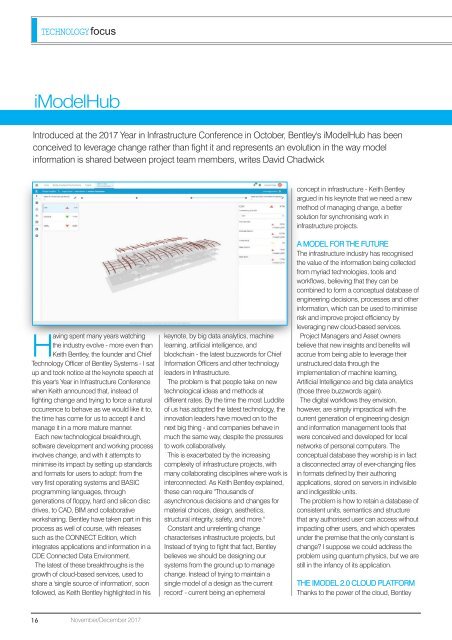Create successful ePaper yourself
Turn your PDF publications into a flip-book with our unique Google optimized e-Paper software.
TECHNOLOGYfocus<br />
iModelHub<br />
Introduced at the 2017 Year in Infrastructure Conference in October, Bentley's iModelHub has been<br />
conceived to leverage change rather than fight it and represents an evolution in the way model<br />
information is shared between project team members, writes David Chadwick<br />
concept in infrastructure - Keith Bentley<br />
argued in his keynote that we need a new<br />
method of managing change, a better<br />
solution for synchronising work in<br />
infrastructure projects.<br />
Having spent many years watching<br />
the industry evolve - more even than<br />
Keith Bentley, the founder and Chief<br />
Technology Officer of Bentley Systems - I sat<br />
up and took notice at the keynote speech at<br />
this year's Year in Infrastructure Conference<br />
when Keith announced that, instead of<br />
fighting change and trying to force a natural<br />
occurrence to behave as we would like it to,<br />
the time has come for us to accept it and<br />
manage it in a more mature manner.<br />
Each new technological breakthrough,<br />
software development and working process<br />
involves change, and with it attempts to<br />
minimise its impact by setting up standards<br />
and formats for users to adopt: from the<br />
very first operating systems and BASIC<br />
programming languages, through<br />
generations of floppy, hard and silicon disc<br />
drives, to CAD, BIM and collaborative<br />
worksharing. Bentley have taken part in this<br />
process as well of course, with releases<br />
such as the CONNECT Edition, which<br />
integrates applications and information in a<br />
CDE Connected Data Environment.<br />
The latest of these breakthroughs is the<br />
growth of cloud-based services, used to<br />
share a 'single source of information', soon<br />
followed, as Keith Bentley highlighted in his<br />
keynote, by big data analytics, machine<br />
learning, artificial intelligence, and<br />
blockchain - the latest buzzwords for Chief<br />
Information Officers and other technology<br />
leaders in Infrastructure.<br />
The problem is that people take on new<br />
technological ideas and methods at<br />
different rates. By the time the most Luddite<br />
of us has adopted the latest technology, the<br />
innovation leaders have moved on to the<br />
next big thing - and companies behave in<br />
much the same way, despite the pressures<br />
to work collaboratively.<br />
This is exacerbated by the increasing<br />
complexity of infrastructure projects, with<br />
many collaborating disciplines where work is<br />
interconnected. As Keith Bentley explained,<br />
these can require ''Thousands of<br />
asynchronous decisions and changes for<br />
material choices, design, aesthetics,<br />
structural integrity, safety, and more.''<br />
Constant and unrelenting change<br />
characterises infrastructure projects, but<br />
Instead of trying to fight that fact, Bentley<br />
believes we should be designing our<br />
systems from the ground up to manage<br />
change. Instead of trying to maintain a<br />
single model of a design as 'the current<br />
record' - current being an ephemeral<br />
A MODEL FOR THE FUTURE<br />
The infrastructure industry has recognised<br />
the value of the information being collected<br />
from myriad technologies, tools and<br />
workflows, believing that they can be<br />
combined to form a conceptual database of<br />
engineering decisions, processes and other<br />
information, which can be used to minimise<br />
risk and improve project efficiency by<br />
leveraging new cloud-based services.<br />
Project Managers and Asset owners<br />
believe that new insights and benefits will<br />
accrue from being able to leverage their<br />
unstructured data through the<br />
implementation of machine learning,<br />
Artificial Intelligence and big data analytics<br />
(those three buzzwords again).<br />
The digital workflows they envision,<br />
however, are simply impractical with the<br />
current generation of engineering design<br />
and information management tools that<br />
were conceived and developed for local<br />
networks of personal computers. The<br />
conceptual database they worship is in fact<br />
a disconnected array of ever-changing files<br />
in formats defined by their authoring<br />
applications, stored on servers in indivisible<br />
and indigestible units.<br />
The problem is how to retain a database of<br />
consistent units, semantics and structure<br />
that any authorised user can access without<br />
impacting other users, and which operates<br />
under the premise that the only constant is<br />
change? I suppose we could address the<br />
problem using quantum physics, but we are<br />
still in the infancy of its application.<br />
THE IMODEL 2.0 CLOUD PLATFORM<br />
Thanks to the power of the cloud, Bentley<br />
16<br />
November/December 2017

















